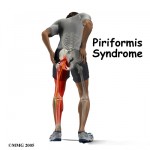About 5 million Americans who suffer from low back pain each year have piriformis syndrome. Piriformis syndrome produces an intense, sometimes crippling pain deep in the buttocks, usually just on one side. It can be a result of prolonged activities, such as jogging, marathon sessions with the computer and with long commutes in a car. Sitting for long periods, vigorously over-exercising, or a combination of sitting and exercise are the most common causes. An accident or, occasionally, a congenital abnormality can also cause this problem.
Even if you have great back mechanics, the piriformis muscle in the buttock may tighten, go into spasm and entrap the sciatic nerve, causing the same symptoms and misery that come with herniated disks. Piriformis syndrome may account for as much as 50 percent of the pain that strikes in the backside and radiates down the back of the leg.
Many internists, neurologists and pain specialists aren’t very familiar with this problem, and mistakenly think the source of the pain is in spinal nerve roots. Because it is so easy to confuse with herniated disk, piriformis syndrome can be extremely difficult to diagnose, partially because MRIs and X-Rays are not diagnostic.
Symptoms
The chief symptom is a pain and tenderness lodged deep in the buttock. which may run down the leg, like an electric shock, an ache, pins and needles or another unpleasant feeling. The reason it feels as if there’s a spasm in the buttock is because the piriformis muscle has knotted up and is actually in a spasm that can go on for days, months, and on occasion even years. The tight muscle may compress and irritate the sciatic nerve, causing the pain to travel along the course of the nerve. That’s sciatica.
Diagnosis
The diagnosis can be made by a comprehensive physical exam. In addition, electrodiagnosis may also help in making the diagnosis. X-Rays and MRIs may help to rule out other causes of back pain.
Treatment
Thankfully almost all cases of piriformis syndrome can be treated without surgery. There are several options. First, there is exercise. Yoga provides many poses, chiefly twisting poses that can help by stretching the piriformis muscle, which often provides immediate relief. Gluteal stretches are also effective. They can be done standing, sitting or lying down.
An injection of a very small amount of steroid with Lidocaine is also an effective way to relax the muscle. After the injection, some sessions with a physical therapist can speed recovery.
Prevention
If you are constantly sitting, it is imprtant to take breaks from sitting whenever you can. And while you are up and walking around, stretch a little. You can sit in your desk chair and do a modified gluteal stretch. If you drive long distances, a gel cushion will make a spasm less likely. When it comes to exercise, be moderate. Gradually increase your workout. Don’t sit for hours and then go for a brisk mile-long jog that will increase the possibility of a muscle spasm.
As with any injury, illness, or condition, always consult a physician if you or someone you know is having spine or other orthopeadic problems. At Non-Surgical Orthopaedics, will be happy to consult with you. Please call us at 770-421-1420 to schedule an appointment at any of our three Georgia facilities if you have questions or concerns about your injury and the type of medication and treatment you should acquire.

